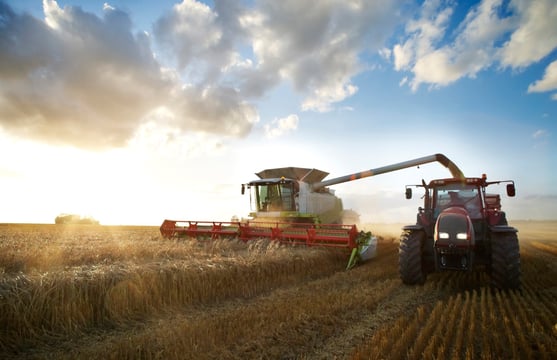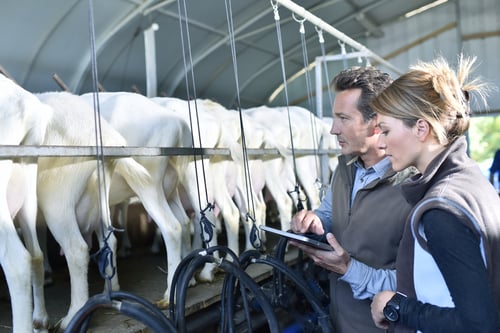Sensor Fusion versus standard sensor solutions

There are now several proven sensor solutions in the agricultural sector. These include distance, position and level sensors. These technologies make machines and installations smarter and allow more food to be produced with less manual labor. But at Sentech, we like to go one step further. In fact, we see plenty of opportunities for integrating different sensors into a single compact application or chip. When combining two sensor technologies, you bring out the best of both worlds. And that pays off. Sensor fusion offers endless possibilities that engineers and OEMs cannot afford to miss out on in 2022.
Are you working on an innovative machine for the agricultural sector, but the known technologies always fall a little short of what you have in mind? Or are there issues that you are not able to solve 100% perfectly? For example, a sensor may be measuring accurately but then stop working properly when the sun is shining. Or an autonomous machine where only using LiDAR to measure distance is not enough. Sensor fusion opens up a whole new world for you. Get to know the next-generation applications.
More accurate measurements with Sensor Fusion
The name says it all: sensor fusion is the combination of several standard sensor solutions. Why, do you ask? In order to achieve better measurement results. For example, by improving the performance of an individual sensor. By having two sensors based on different technologies working together, you can make the measurement more accurate. Where you can use one sensor to measure to the nearest centimeter, combining two sensors allows you to measure to half a centimeter. Or where one sensor measures in liters, two of the same sensors can do so to the nearest half liter. Measuring is knowing, and this is how you can improve measurement results step by step. This is ideal for precision agriculture, where technology helps give crops and animals the exact treatment they need.
The best of both worlds in one sensor
You can also take advantage of the improved properties that using two different sensors offers. For example, when you want to measure distance in a place where it can get very dusty, such as on agricultural land. In that case, you can use the highly accurate properties of the optical sensor coupled with the dust resistant prowess of an ultrasonic sensor. When compared to LiDAR, radar has fewer limitations when it comes to extreme weather conditions such as snow, fog and rain. In addition, radar can see through barriers and detect soil through crops. That makes radar an intriguing option for agricultural vehicles. On the other hand, LiDAR is better able to accurately determine the size and shape of objects. This is also useful for autonomous agricultural machines. In situations like this, sensor fusion is the best solution. You leverage the power of both technologies in one sensor resulting in: 1 + 1 = 3.
Want to read more about tangible examples and proven combinations? If so, then this article is a must-read: ‘Sensor Fusion is the Future’.
More luxury products and lower cost
Not only does sensor fusion improve measurement results, it can also provide financial benefits. In fact, if you use two lower-cost sensors in one application, you may end up with the specifications of a much better and more expensive product. Or you may be able to combine multiple sensor applications into one sensor, saving on the purchase of a complete sensor. Consider a sensor that measures the presence of oil in a tank or the quantity of milk, and a temperature sensor that checks that the oil is not getting too hot or, conversely, that the milk is cool enough. By adding that temperature sensor to our product, you save on purchasing an entire sensor. That includes making a hole in the tank, connecting a plug and wiring. Taking multiple measurements with one sensor can simplify the application and be more cost effective.
What is there to consider with Sensor Fusion?
In order to combine sensors properly, you need specialized knowledge. After all, you will be using certain specifications of two sensors interchangeably. It is important for this combination to produce exactly the right results, ensuring that the customer's application becomes smarter and better. This requires a lot of hands-on experience from someone who has thoroughly tested the application. All the more reason to always have an experienced specialist lend a hand when developing this kind of sensor. Compare it to decorating a house. You can buy a bookcase and couch separately in different stores when decorating your living room, but if you really want a comprehensive solution then choose an interior decorator. The same applies to sensor technology. So make sure to get good advice!
Getting started with a specialist
Sensor fusion vastly expands the number of options and capabilities that sensor technology can offer. Are you facing an issue in the agricultural sector where known technologies always fall a little short? Or are there complications that you just can't seem to get past? For example, a sensor that measures accurately enough but then stops working properly when the sun is shining. Or a machine that runs autonomously and where just LiDAR or just ultrasonic distance measurement is not enough. Then sensor fusion is the solution. Because that technology allows you to:
- Improve measurement performance and make it more accurate.
- Combine the best of both worlds in one sensor.
- Take advantage of the best technologies.
Making the right combinations when it comes to sensor fusion requires experience and specialist knowledge. And that is precisely where Sentech's expertise lies. Want to know more about sensor fusion or get advice from one of our specialists? We will be happy to help you. Contact us for a consultation with no obligation.


.png)

